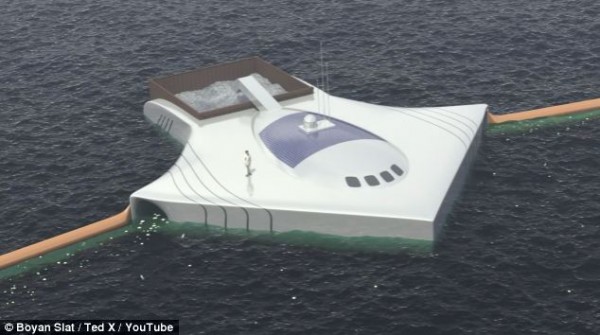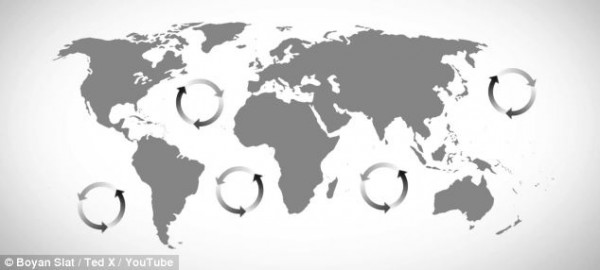
Plastic might be a cheap, versatile and useful material, but it’s also an environmental disaster. We produce around 300 million tons of plastic per year, and since 1950 we have produced around 6 billion metric tons of the stuff. It’s clogging up landfills, becoming trapped in Arctic ice, polluting our oceans and harming wildlife. Recently, we heard the results of a survey of the seafloor off the European coast which revealed garbage as deep as 4.5 kilometers below the surface.
Plastic in the marine environment receives a lot of attention because of the potential disastrous consequences on marine life. It is estimated that at least 1 million seabirds die each year due to plastic pollution. Entanglement is also a huge problem which can lead to death through illness or suffocation. Various marine organisms such as fish also eat plastic which can damage the digestive system and lead to malnutrition. Furthermore, it’s also an extremely costly problem; marine debris is estimated to cause around $1.27 million per year in fishing and vessel damage, and the costs of removing the trash is tremendous.
But all might not be lost. An organization called The Ocean Cleanup, founded by 19-year-old Boyan Slat, believe that they may have a viable solution to cleanup ocean trash. Following a year-long study involving extensive scientific research, the organization has recently released a feasibility report which concludes that their novel method to remove plastic from the oceans is both technically and financially viable. Furthermore, if employed, computer models predict that within ten years they could reduce the plastic within the infamous Great Pacific Garbage Patch, which has been previously deemed impossible to cleanup, by almost 50%.
How does it work? Their method exploits natural ocean currents and winds which passively transport garbage towards a collection platform. Solid floating barriers are then used to catch and concentrate the trash from the ocean, negating the risk of wildlife entanglement and vertebrate bycatch which are problems with other techniques such as nets.
Their first proof-of-concept test, which was performed at the Azores Islands, confirmed the capture and concentration potential of the floating barriers. After capture the plastic is removed mechanically and, according to the report, if it can be converted into other materials or oil some of the costs could potentially be recovered.
So what’s the catch? Cleanup projects unfortunately don’t come cheap, and the team estimate that this will cost €31.7 million per year (around $43 million). While this may sound dramatic, according to the report it’s actually around 33 times cheaper than other conventional cleanup methods that have been proposed to deal with the problem. But to minimize costs, The Ocean Cleanup is outsourcing most of the fundamental research to institutes and is also collaborating with various companies. In order to implement the next stage of the project, which will involve large-scale operational pilots, the company is now crowdsourcing $2 million.
While cleanup is certainly necessary to tackle the current problem, Slat emphasizes in a news-release that more needs to be done: “Although a cleanup will have a profound effect, it is just part of the solution. We also need to close the tap, to prevent any more plastic from reaching the oceans in the first place.”
Check out this YouTube video to find out more:

Millions of tonnes of plastic debris are littering oceans and have accumulated in areas of high concentration called gyres (pictured by the circles of arrows) which are essentially floating rubbish tips








 Photographer Finds Locations Of 1960s Postcards To See How They Look Today, And The Difference Is Unbelievable
Photographer Finds Locations Of 1960s Postcards To See How They Look Today, And The Difference Is Unbelievable  Hij zet 3 IKEA kastjes tegen elkaar aan en maakt dit voor zijn vrouw…Wat een gaaf resultaat!!
Hij zet 3 IKEA kastjes tegen elkaar aan en maakt dit voor zijn vrouw…Wat een gaaf resultaat!!  Scientists Discover 512-Year-Old Shark, Which Would Be The Oldest Living Vertebrate On The Planet
Scientists Discover 512-Year-Old Shark, Which Would Be The Oldest Living Vertebrate On The Planet  Hus til salg er kun 22 kvadratmeter – men vent til du ser det indvendigt
Hus til salg er kun 22 kvadratmeter – men vent til du ser det indvendigt  Superknepet – så blir snuskiga ugnsformen som ny igen!
Superknepet – så blir snuskiga ugnsformen som ny igen!  Meteorite That Recently Fell in Somalia Turns Out to Contain Two Minerals Never Before Seen on Earth
Meteorite That Recently Fell in Somalia Turns Out to Contain Two Minerals Never Before Seen on Earth  Nearly Frozen Waves Captured On Camera By Nantucket Photographer
Nearly Frozen Waves Captured On Camera By Nantucket Photographer  It’s Official: Astronomers Have Discovered another Earth
It’s Official: Astronomers Have Discovered another Earth 